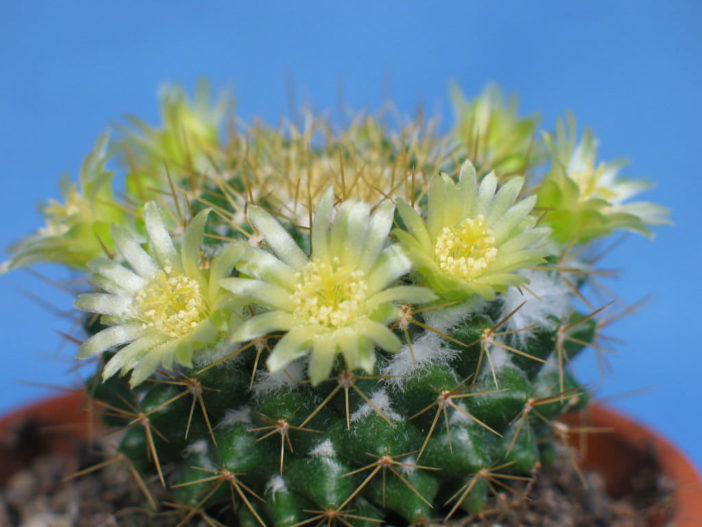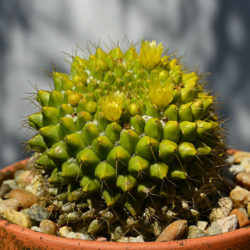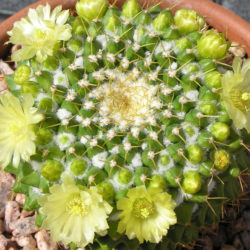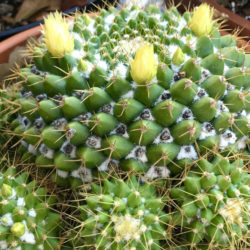Scientific Name
Mammillaria marksiana Krainz
Synonym(s)
Neomammillaria marksiana
Scientific Classification
Family: Cactaceae
Subfamily: Cactoideae
Tribe: Cacteae
Subtribe: Cactinae
Genus: Mammillaria
Origin
Mammillaria marksiana is native to northwestern Mexico. It grows on limestone cliffs at elevations that range from 1,310 to 6,560 feet (400 to 2,000 m) in Durango and Sinaloa.
Description
Mammillaria marksiana is a beautiful small cactus with flattened globose stems with pyramidal tubercles woolly in the axils and tipped with white-felted areoles that bear clusters of golden yellow to brown spines. The stems can become slightly column-shaped with age and produce offsets to form a clump. The stems are light green, turning yellowish in bright light. They can grow up to 6 inches (15 cm) tall and up to 5 inches (12.5 cm) in diameter.
The blooming area is usually covered with snow-white wool. The bright greenish-yellow flowers are funnel-shaped, reaching up to 0.6 inches (1.5 cm) in length and diameter, and appear in late winter and early spring. The fruits are dark purplish-red, club-shaped, about 20 mm (0.8 in) long, and contain numerous tiny brown seeds.

Hardiness
USDA hardiness zone 9b to 11b: from 25 °F (−3.9 °C) to 50 °F (+10 °C).
How to Grow and Care
To encourage better flowering, allow the plants to enjoy a cooling period in the winter and suspend watering. Unlike many other cacti, which use their ribs as storage devices, Mammillaria feature raised tubercles, from which spines emerge. When you water, the tubercles will expand for increased water storage. The flowers emerge from the axils of these tubercles on the previous year's growth, which accounts for their interesting halo effect. The cactus mustn't be exposed to prolonged dampness and sitting water. Never let your cactus sit in a dish of water. Lastly, ensure to fertilize during the growing season for the best results.
Repot as needed, preferably during the warm season. To repot Mammillaria, make sure the soil is dry before repotting, then gently remove the pot. Knock away the old soil from the roots, making sure to remove any rotted or dead roots in the process. Treat any cuts with a fungicide. Place the plant in its new pot and backfill with potting soil, spreading the roots out as you repot. Leave the plant dry for a week or so, then begin to water lightly to reduce the risk of root rot.
See more at How to Grow and Care for Mammillaria.
Links
- Back to genus Mammillaria
- Succupedia: Browse succulents by Scientific Name, Common Name, Genus, Family, USDA Hardiness Zone, Origin, or cacti by Genus
Photo Gallery
Click on a photo to see a larger version.


